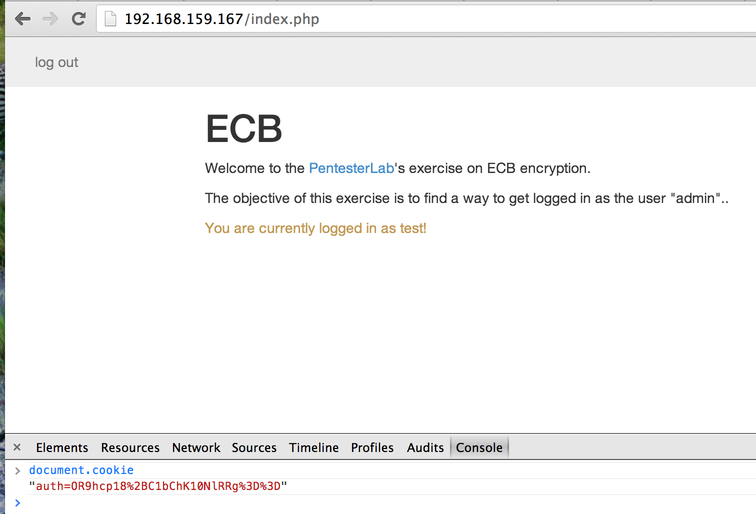Introduction
This course details the exploitation of a weakness in the authentication of a PHP website. The website uses ECB to encrypt information provided by users and use this information to ensure authentication. We will see how this behavior can impact the authentication and how it can be exploited.
If you feel confident, you can try to do this exercise without following the course, then you can come back to the course to read some details and tips. If you want to do it by yourself, you can follow the following steps:
- Create 2 users with similar usernames:
test1andtest2and the same passwordpassword, then look at the cookie sent back by the application. - Create a user with a really long name composed of the same character (like 20 times
a) and look at the cookie sent back by the application. Try to look for a pattern that will give you more information on how the information can be manipulated. - Try to create a user with a
usernameand apasswordthat will allow you to be logged in asadminby removing the encrypted data. - Try to create a user with a
usernamethat will allow you to be logged in asadminby swapping encrypted blocks around.
ECB
ECB is an encryption mode in which the message is split into blocks of X bytes length and each block is encrypted separately using a key.
The following schema (source: Wikipedia) explains this method:

During the decryption, the reverse operation is used. Using ECB has multiple security implications:
- Blocks from encrypted messages can be removed without disturbing the decryption process.
- Blocks from encrypted messages can be moved around without disturbing the decryption process.
In this exercise, we will see how we can exploit these two weaknesses.
Detection of the vulnerability
In this exercise, you can register an account and log in with this account (to make things easier, you get automatically logged in when you register).
If you create an account and log in two times with this account, you can see that the cookie sent by the application didn't change.
If we look at the cookie, we can see that it seems URI-encoded and base64-encoded:

The 2 equals sign encoded as %3d%3d are a good indicator of a base64-encoded string.
We can decode it using the following ruby code:
% irb
> require 'base64' ; require 'uri'
=> true
> Base64.decode64(URI.decode("OR9hcp18%2BC1bChK10NlRRg%3d%3d"))
=> "9\x1Far\x9D|\xF8-[\n\x12\xB5\xD0\xD9QF"Or by decoding the URI to a string manually and use the base64 command:
% echo "OR9hcp18+C1bChK10NlRRg==" | base64 -D | hexdump -C
0000000 39 1f 61 72 9d 7c f8 2d 5b 0a 12 b5 d0 d9 51 46 |9.ar.|.-[.....QF|
0000010In both cases, we can see that the information seems to be encrypted.
First, we can start by creating two accounts test1 and test2 with the same password: password and compare the cookies sent by the application. We get the following cookies (after URI-decoding):
| Account: | test1 | test2 |
| Cookie: | vHMQ+Nq9C3MHT8ZkGeMr4w== |
Mh+JMH1OMhcHT8ZkGeMr4w== |
If we base64-decode both cookies, we get the following strings:
| Account: | test1 | test2 |
| Decoded cookie: | \xBCs\x10\xF8\xDA\xBD\vs\aO\xC6d\x19\xE3+\xE3 |
2\x1F\x890}N2\x17\aO\xC6d\x19\xE3+\xE3 |
We can see that part of the decrypted values look really similar.
Now we can try to create a user with an arbitrary long username and password. For example, a username composed of 20 a and a password composed of 20 a. By creating this user, we get the following cookie:
> document.cookie
"auth=GkzSM2vKHdcaTNIza8od1wS28inRHiC2GkzSM2vKHdcaTNIza8od1ys96EXmirn5"If we decode this value, we get the following:
\x1AL\xD23k\xCA\x1D\xD7\x1AL\xD23k\xCA\x1D\xD7\x04\xB6\xF2)\xD1\x1E \xB6\x1AL\xD23k\xCA\x1D\xD7\x1AL\xD23k\xCA\x1D\xD7+=\xE8E\xE6\x8A\xB9\xF9We can see that the following pattern (composed of 8 bytes): \x1AL\xD23k\xCA\x1D\xD7 comes back multiple times:
\x1AL\xD23k\xCA\x1D\xD7\x1AL\xD23k\xCA\x1D\xD7\x04\xB6\xF2)\xD1\x1E \xB6\x1AL\xD23k\xCA\x1D\xD7\x1AL\xD23k\xCA\x1D\xD7+=\xE8E\xE6\x8A\xB9\xF9Based on the pattern size, we can infer that the ECB encryption uses a block size of 8 bytes.
The decoded information also shows us that the username and password are not directly concatenated and that a delimiter is added (since one of the block in the middle is different from the previous one).
We can think of the encrypted stream has one of the two following possibilities:
- The stream contains the
username, adelimiterand thepassword:

- The stream contains the password, a
delimiterand theusername:

By creating another user with a long username and a short password, we can confirm that the following pattern is used: username|delimiter|password.
Now let's try to find the delimiter size, if we play with different size of username and password we get the following results:
| Username length | Password length | Username+Password length | Cookie's length (after decoding) |
| 2 | 3 | 5 | 8 |
| 3 | 3 | 6 | 8 |
| 3 | 4 | 7 | 8 |
| 4 | 4 | 8 | 16 |
| 4 | 5 | 9 | 16 |
We can see that the size of the decoded cookie goes from 8 to 16 bytes when the length of the Username+Password is greater than 7. We can infer from this value that the delimiter is a single byte since the encryption is done per block of 8 bytes.
Another important thing is to see what part of the encrypted stream is used by the application when we send the cookie back. If we remove everything after the block corresponding to the delimiter, we can see that we are still authenticated. The password does not seem to be used when the cookie gets used by the application.
We now know that we just need to get the correct username|delimiter to get authenticated within the application as username.
Exploitation of the vulnerability
The easiest way to get admin access is to remove some of the encrypted data. We know that the application uses the following format:
[username]:[delimiter]And only uses the username when the cookie is sent back to the application. We also know that each block of 8 bytes is completely independent (ECB). To exploit this issue, we can create a username that contains 8 characters followed by the word admin:
aaaaaaaaadminAnd we will receive the cookie (retrieved using the Javascript Console):
> document.cookie
"auth=GkzSM2vKHdfgVmQuKXLregdPxmQZ4yvj"This value will get decoded as:
\x1AL\xD23k\xCA\x1D\xD7\xE0Vd.)r\xEBz\aO\xC6d\x19\xE3+\xE3We can see the pattern \x1AL\xD23k\xCA\x1D\xD7 detected previously with the username that contained 20 a.
We can then remove the first 8 bytes of information and re-encode our payload to get a new cookie:
\xE0Vd.)r\xEBz\aO\xC6d\x19\xE3+\xE3That will get encoded by the following ruby code:
% irb
> require 'cgi'; require 'base64'
=> true
> CGI.escape(Base64.strict_encode64("\xE0Vd.)r\xEBz\aO\xC6d\x19\xE3+\xE3"))
=> "4FZkLily63oHT8ZkGeMr4w%3D%3D"Once you modify the cookie:

And send this value back to the application (by reloading the page), you get logged in as admin:

A more complicated way to bypass this is to swap data around. We can make the assumption that the application will use a SQL query to retrieve information from the user based on their username. For some databases, when using the type of data VARCHAR (as opposed to BINARY for example), the following will give the same result:
SELECT * FROM users WHERE username='admin';SELECT * FROM users WHERE username='admin ';The spaces after the value admin are ignored during the string comparison. We will use this to play with the encrypted blocks.
Our goal is to end up with the following encrypted data:
ECB(admin [delimiter]password)We know that our delimiter is only composed of one byte. We can use this information to create the perfect username and password to be able to swap the blocks and get the correct forged value.
We need to find a username and a password for which:
- The
passwordstarts withadminto be used as the newusername. - The encrypted
passwordshould be located at the start of a new block. - The
username+delimiterlength should be divisible by the block size (from the previous conditions)
By playing around, we can see that the following values work:
- A
usernamecomposed ofpassword(8 bytes) followed by 7 spaces (1 bytewill be used by thedelimiter). - A
passwordcomposed ofadminfollowed by 3 spaces (8 - length("admin")).
If you create correctly this user, the encrypted information will look like:

Using some Ruby (or even with Burp decoder), you can swap the first 8 bytes with the last 8 bytes to get the following encrypted stream:

Once you modify your cookie, and you reload the page, you should be logged in as admin:

Conclusion
This exercise showed you how you can tamper with encrypted information without decrypting it and use this behavior to gain access to other's accounts. It showed you that encryption can not be used as a replacement for signature and how it's possible to use ECB encryption to get control over the decrypted information.
I hope you enjoyed learning with PentesterLab.